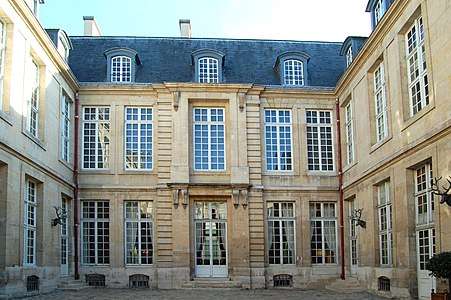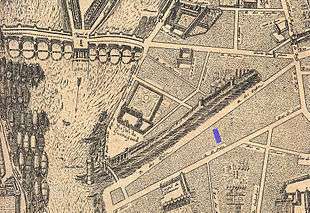Hôtel de Guénégaud

Hôtel de Guénégaud refers to one of several 17th-century hôtels particulier, or large townhouses, in Paris.
3rd arrondissement of Paris
At 60, rue des Archives in the 3rd arrondissement of Paris, this Hôtel de Guénégaud was built between 1651 and 1655 for Jean-François de Guénégaud des Brosses, secrétaire du Roi, maître des Comptes and conseiller d'État, by François Mansart (the only hôtel particulier this architect built to have fully survived). It now houses the Musée de la Chasse et de la Nature and the Club de la chasse et de la nature. It is served by the Arts et Métiers and Filles du Calvaire Metro stations.
Left bank

Hôtel de Nevers
On the site of the present day Hôtel des Monnaies (1768), the Hôtel de Nevers[1] (on the quai de Nevers, just east of the Tour de Nesle) was purchased in 1646 by Henri de Guénégaud and transformed by the architect François Mansart into the Hôtel de Guénégaud in 1648–1652. The rue Guénégaud was created on the garden side of the hôtel. In 1670 ownership of this Hôtel de Guénégaud was transferred to one of Cardinal Mazarin's nieces, Anne-Marie Martinozzi, Princesse de Conti, and it became known as the Hôtel de Conti.[2] The quai de Nevers became the quai de Conti, but the name of the rue Guénégaud has remained unchanged up to the present day.
Guénégaud Theatre
The first theatre of the Comédie-Française, the Salle de la Bouteille (1671, now demolished), was also referred to as the Hôtel de Guénégaud.[3]
References
Notes
- ↑ This Hôtel de Nevers should not be confused with one on the right bank on the rue de Richelieu which was part of the Palais Mazarin and was later incorporated into the old Bibliothèque Nationale de France; see also French Wikipédia Hôtel de Nevers (rue de Richelieu). A garden gallery of the latter hôtel had been designed by François Mansart ca. 1644–45 and was originally part of the immediately adjacent Hôtel Tubeuf, to which Mansart also made alterations; see also French Wikipédia Hôtel Tubeuf (rue des Petits-Champs). Of Mansart's designs only the exterior, and not the interior, of the garden gallery survives in somewhat altered form, with crossed quivers and garlands typical of Mansart visible above the upper windows (Braham and Smith 1973, pp. 70–73, 223–226, plates 318, 319; photo at Commons).
- ↑ Braham & Smith 1973, pp. 237–241.
- ↑ Clarke 1998, pp. 1, 112.
Sources